Slender sea slug (Microchlamylla gracilis)
Distribution data supplied by the Ocean Biodiversity Information System (OBIS). To interrogate UK data visit the NBN Atlas.Map Help
| Researched by | Rose Edwards | Refereed by | Admin |
| Authority | (Alder & Hancock, 1844) | ||
| Other common names | Slender aeolis | Synonyms | Coryphella smaragdina Alder & Hancock 1851, Flabellina gracilis , Coryphella verrucosa smaragdina , Coryphella smaragdina Alder & Hancock 1851, Flabellina gracilis (Alder & Hancock, 1844), Coryphella verrucosa smaragdina ., Coryphella gracilis |
Summary
Description
Microchlamylla gracilis has a translucent white body with tentacles (cerata) filled with red-coloured digestive gland. There are up to six clusters of cerata that all have thin rings of white pigments at the tips. This small species can grow up to 1.5 cm in length, and can be easily confused with juveniles of other Coryphellidae. However, mature individuals, of 1-1.2 cm long, have opaque white globules (ovotestis) present internally, which can be seen through their translucent bodies. These globules are absent from juveniles. Feeds on hydroids especially Eudendrium spp. The eggs are spawned in the form of a white string wound amongst the food and when laid flat forms a squared-spiral shape.
Recorded distribution in Britain and Ireland
This species has been recorded on all British coasts.Global distribution
Recorded from the British Isles, Iceland and the Atlantic coast of America.Habitat
Coryphella gracilis prefers localities where there is water movement from tidal streams in semi-sheltered conditions.Depth range
-Identifying features
- Translucent white body, red-coloured cerata with white tips.
- Up to six clusters of cerata.
- The anus is situated between the second and third set of cerata clusters.
- Small species, grows up to 1.5 cm in length.
Additional information
Individuals with green coloured cerata occur occasionally and have been recorded as the variety Microchlamylla gracilis smaragdina. Feeds on hydroids, especially Eudendrium arbusculum and is usually found in large numbers (Picton & Morrow, 1994).
Listed by
- none -
Bibliography
Hayward, P.J. & Ryland, J.S. (ed.), 1995. The marine fauna of the British Isles and north-west Europe. Volume 2. Molluscs to Chordates. Oxford Science Publications. Oxford: Clarendon Press.
Howson, C.M. & Picton, B.E., 1997. The species directory of the marine fauna and flora of the British Isles and surrounding seas. Belfast: Ulster Museum. [Ulster Museum publication, no. 276.]
JNCC (Joint Nature Conservation Committee), 1999. Marine Environment Resource Mapping And Information Database (MERMAID): Marine Nature Conservation Review Survey Database. [on-line] http://www.jncc.gov.uk/mermaid
Picton, B. E. & Morrow, C.C., 1994. A Field Guide to the Nudibranchs of the British Isles. London: Immel Publishing Ltd.
Picton, B.E., 2000. Nudibranchs of the British Isles. http://www.pictonb.freeserve.co.uk/nudibranchs/index.html, 2003-09-11
Thompson, T. E. & Brown, G. H., 1976. British Opisthobranch Molluscs. London: Academic Press. [Synopses of the British Fauna, no. 8.]
Datasets
NBN (National Biodiversity Network) Atlas. Available from: https://www.nbnatlas.org.
OBIS (Ocean Biodiversity Information System), 2025. Global map of species distribution using gridded data. Available from: Ocean Biogeographic Information System. www.iobis.org. Accessed: 2025-07-26
Citation
This review can be cited as:
Last Updated: 08/06/2007



